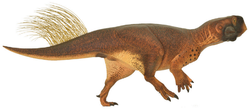You can help expand this article with text translated from the corresponding article in Italian. (July 2013)Click [show] for important translation instructions.
|
| Vagaceratops Temporal range: Late Cretaceous, | |
|---|---|
 | |
| Cast of the holotype skull, Canadian Museum of Nature | |
| Scientific classification | |
| Kingdom: | Animalia |
| Phylum: | Chordata |
| Class: | Reptilia |
| Clade: | Dinosauria |
| Clade: | † Ornithischia |
| Clade: | † Ceratopsia |
| Family: | † Ceratopsidae |
| Subfamily: | † Chasmosaurinae |
| Genus: | † Vagaceratops Sampson et al., 2010 |
| Species: | †V. irvinensis |
| Binomial name | |
| †Vagaceratops irvinensis (Holmes et al., 2001 [originally Chasmosaurus ]) | |
| Synonyms | |
| |
Vagaceratops (meaning "wandering (vagus, Latin) horned face", in reference to its close relationship with Kosmoceratops from Utah) is a genus of chasmosaurine ceratopsid dinosaur which lived during the Late Cretaceous period (late Campanian) in what is now Alberta. Its fossils have been recovered from the Upper Dinosaur Park Formation. It is sometimes included in the genus Chasmosaurus as Chasmosaurus irvinensis instead of being recognized as its own genus.






